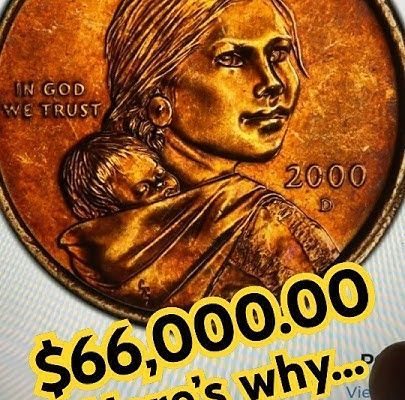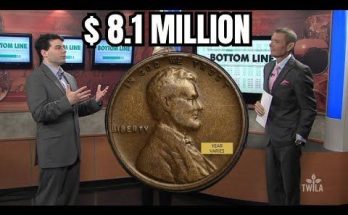
At PennyVerse.info, we love investigating viral coin claims—and today we’re looking at one making the rounds online: a “$66,000 Sacagawea Gold Dollar Error.”
Before you run to the bank with your coin, let’s uncover the facts, separate myths from reality, and show you exactly what makes some Sacagawea Dollars truly valuable.
 Myth Busted: Is It Really Made of Gold?
Myth Busted: Is It Really Made of Gold?
Nope! Despite the golden shine, regular Sacagawea Dollars are NOT gold.
Here’s what they’re really made of:
- Manganese brass cladding over a pure copper core.
- That yellow tone is just the metal alloy—not real gold.


 The $66,000 Question: What’s the Error?
The $66,000 Question: What’s the Error?
The viral claim never says what the actual error is—and that’s the problem.
Coin value comes from specific, rare errors, not just the year or design.
Here are the real high-value Sacagawea Dollar errors:
 2000-D Sacagawea / South Carolina Quarter Mule
2000-D Sacagawea / South Carolina Quarter Mule 
- Most famous error for this coin.
- Wrong dies used: Sacagawea obverse + South Carolina quarter reverse.
- Value: Over $100,000 for top examples.
 Striking or Planchet Errors
Striking or Planchet Errors 
- Wrong metal planchet or dramatic off-center strikes.
- Rare enough to reach tens of thousands.
 2000-P “Wounded Eagle”
2000-P “Wounded Eagle” 
- Lines through the eagle’s tail feathers.
- Worth hundreds to a few thousand—not $66K.

 How to Spot a Potentially Valuable Sacagawea Dollar
How to Spot a Potentially Valuable Sacagawea Dollar
When inspecting your coin, check these key points:
Front (Obverse)
- Sacagawea with her child.
- Year & mint mark (e.g., 2000-D).
Back (Reverse)
- Should show a flying eagle.
- If it has a state quarter design, you’ve likely found a mule error.
Edge
- Smooth/plain. Reeding or unusual marks could indicate a rare planchet strike.
 5-Step Authentication Checklist
5-Step Authentication Checklist
If you suspect your Sacagawea Dollar is rare:
- Identify the exact error (mule, planchet, strike).
- Compare with known examples from trusted sources.
- Weigh and check composition (should be ~8.1g).
- Check for alterations—no post-mint damage.
- Submit to PCGS or NGC for grading & certification.
 Why Some Sacagawea Dollars Are Worth Big Money
Why Some Sacagawea Dollars Are Worth Big Money



 How to Sell a Verified High-Value Coin
How to Sell a Verified High-Value Coin
If you own a certified treasure:
- Use top-tier auction houses (Heritage, Stack’s Bowers).
- Work with specialized modern coin dealers.

 Think You Have One? Do This NOW
Think You Have One? Do This NOW
Email us with:
- Clear, close-up photos (front, back, error).
- Short video in good lighting.
- How you got the coin.

- Initial coin evaluation.
- Guidance on grading & selling.

“In the world of modern coins, true value lies in precise error identification and professional verification. Always ask—‘What is the error?’”
— Dr. Eleanor Vance, Chief Numismatist, RareCoin Guild



